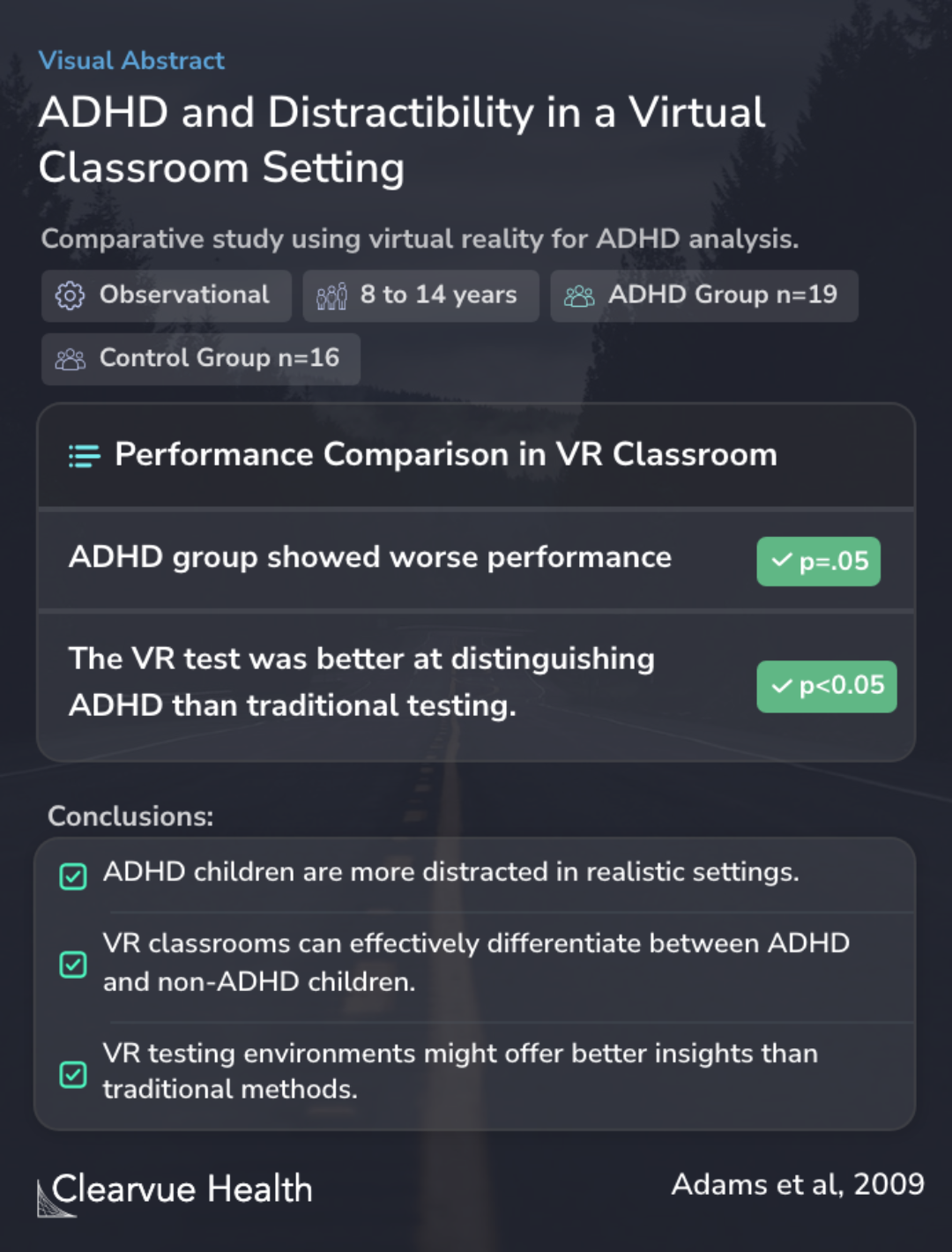Distractibility in Attention/Deficit/ Hyperactivity Disorder (ADHD): the virtual reality classroom
ADHD and Distractibility in a Virtual Classroom Setting
Adams R, Finn P, Moes E, Flannery K, Rizzo AS

Objectives
This study aimed to understand how distractions in a classroom setting affect children with Attention Deficit Hyperactivity Disorder (ADHD) compared to those without the condition. Researchers focused on children aged 8 to 14, using a virtual reality (VR) classroom to simulate real-world distractions. This setting was chosen because it closely mirrors an actual classroom environment, a unique approach in ADHD research. The study's objective was to quantitatively assess the impact of distractions on children with ADHD and compare their responses to those of age-matched controls without ADHD.
Nineteen boys aged 8 to 14 with a diagnosis of ADHD and 16 age-matched controls were compared in a virtual reality (VR) classroom version of a continuous performance task (CPT), with a second standard CPT presentation using the same projection display dome system. The Virtual Classroom i...
Methods
The study involved nineteen boys diagnosed with ADHD and sixteen age-matched controls. They were assessed using a Continuous Performance Task (CPT) in two different formats: a virtual reality classroom and a standard presentation. The VR classroom was designed to include auditory and visual distractors that mimic a real-world classroom setting.
Nineteen boys aged 8 to 14 with a diagnosis of ADHD and 16 age-matched controls were compared in a virtual reality (VR) classroom version of a continuous performance task (CPT), with a second standard CPT presentation using the same projection display dome system. The Virtual Classroom i...
Results
The results showed a notable difference in performance between the ADHD group and the control group. In the VR classroom, children with ADHD were more adversely affected by distractions compared to the control group. This difference approached statistical significance, highlighting the impact of environmental factors on children with ADHD. Additionally, the VR classroom was found to be more effective in distinguishing between ADHD and non-ADHD children compared to the standard CPT.
The difference between the ADHD group (who performed worse) and the control group approached significance (p = .05; adjusted p = .02) in the Virtual Classroom presentation, and the classification rate of the Virtual Classroom was better than when the standard CPT was used (87.5% versus 6...
Conclusions
The study concluded that children with ADHD are more susceptible to distractions in a VR classroom setting than those without ADHD. These findings underscore the importance of minimizing distractions in educational settings, especially for children with ADHD. The study also suggests that virtual reality could be a valuable tool in researching real-world scenarios, providing insights into how environmental factors affect children with ADHD.
Children with ADHD were more affected by distractions in the VR classroom than those without ADHD. Results are discussed in relation to distractibility in ADHD.
Key Takeaways
Context
In the broader context of ADHD research, this study contributes valuable insights. For example, a study by Biederman et al. (2007) found that medications like Vyvanse and Adderall can improve behavior, attention, and math skills in children with ADHD. This suggests that treatment can enhance classroom performance for students with ADHD.
Additionally, Forster et al. (2014) found that increasing perceptual load can significantly reduce distraction in adults with ADHD. This highlights another strategy for managing ADHD symptoms: engaging students in challenging tasks to minimize distractions.